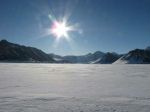
The greatest distance at which it is just possible to see and recognize with the unaided eye (1) in the daytime, a prominent dark object against the sky at the horizon, and (2) at night, a known, preferably unfocused, moderately intense light source.

